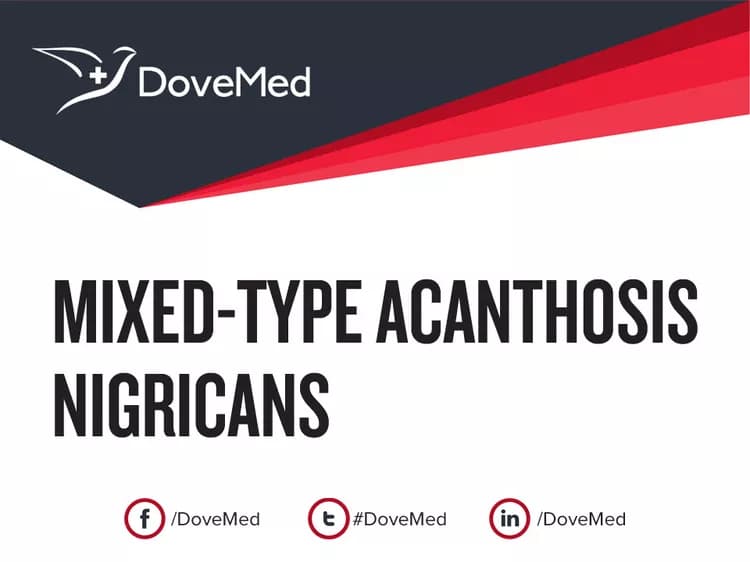
Mixed-Type Acanthosis Nigricans
What are the other Names for this Condition? (Also known as/Synonyms)
- Acanthosis Nigricans, Mixed-Type
- Mixed-Type AN
What is Mixed-Type Acanthosis Nigricans? (Definition/Background Information)
- Acanthosis Nigricans (AN) is a skin condition that causes thick, velvety, and darkened skin areas (due to increased thickness of epidermis). It commonly affects the skin of the armpits, the groin region, head and neck (back of the neck), and anal/genital region.
- Acanthosis Nigricans is not contagious and it cannot be transmitted from one individual to another. It is associated with many disorders such as obesity, diabetes, and malignancy
- Mixed-Type Acanthosis Nigricans is one among the 7 types of Acanthosis Nigricans. In mixed type, more than one type of Acanthosis Nigricans is present. The individual may have one type of Acanthosis Nigricans initially and then develop another type. This can cause diagnostic challenges
- Mixed-Type Acanthosis Nigricans is diagnosed by a thorough clinical history and physical examination. Even though it is a benign condition, dermatologist consultation and testing is necessary to rule out other causes of Acanthosis Nigricans and identify the specific type of AN
- There is no definitive treatment for Mixed Type Acanthosis Nigricans. Certain treatment modalities may be used for cosmetic reasons. Also, treatment of any associated underlying condition is warranted and is undertaken
- The prognosis of skin lesions as such is excellent with no known major complications being observed. However, the overall prognosis of Acanthosis Nigricans, Mixed Type, depends on the underlying/associated condition and the severity of the signs and symptoms
Who gets Mixed-Type Acanthosis Nigricans? (Age and Sex Distribution)
- Acanthosis Nigricans is seen all over the world, though some subtypes are more common among certain age groups, certain parts of the world, or among certain racial or ethnic populations
- Since Mixed-Type Acanthosis Nigricans is mixture of more than one type of Acanthosis Nigricans, the occurrence depends on the subtype the individuals are affected by:
- The benign type is more commonly observed in sub-Saharan regions
- Hereditary-Type Acanthosis Nigricans may be present at birth or may develop later during childhood
- Malignancy-Associated Acanthosis Nigricans is usually seen in individuals over 40 years of age
- In the US, the benign type and obesity associated type is more common in individuals with darker skin tones such as in African Americans, Native American, and Latin American populations
- Both males and females of all races and ethnicities can be affected
What are the Risk Factors for Mixed-Type Acanthosis Nigricans? (Predisposing Factors)
Since Mixed-Type Acanthosis Nigricans is mixture of more than one type of Acanthosis Nigricans, the risk factors depend on the subtypes of Acanthosis Nigricans present in the individual. The following are the known risk factors of different types of Acanthosis Nigricans:
- Syndromic Acanthosis Nigricans is associated with certain syndromes (that are constellation of signs and symptoms that occur together and characterize a particular abnormality) such as Prader Willi syndrome and Alstrom syndrome
- Medications, such as nicotinic acid, oral contraceptives, systemic corticosteroids, and insulin injection (localized to injection site) may precipitate Drug-Induced Acanthosis Nigricans
- In Malignancy-Associated Acanthosis Nigricans, cancers of stomach (most common), colon, liver, endometrium, and other sites may be risk factors
- In Hereditary-Type Acanthosis Nigricans, the condition is inherited in an autosomal dominant pattern
It is important to note that having a risk factor does not mean that one will get the condition. A risk factor increases one's chances of getting a condition compared to an individual without the risk factors. Some risk factors are more important than others.
Also, not having a risk factor does not mean that an individual will not get the condition. It is always important to discuss the effect of risk factors with your healthcare provider.
What are the Causes of Mixed-Type Acanthosis Nigricans? (Etiology)
Mixed-Type Acanthosis Nigricans is seen in a variety of clinical conditions and can be caused by multiple mechanisms.
- Scientist believe that it is caused by certain growth factors which stimulate the proliferation of cells of the skin (called keratinocytes and dermal fibroblasts)
- In certain types of Acanthosis Nigricans, the lesions can form due to insulin resistance
- Insulin resistance results when the activity of insulin hormone is impaired at the site of its action. Insulin resistance is common in those with diabetes type 2 and obesity
- Because of insulin resistance, the body secretes more insulin (a condition termed as hyperinsulinemia) as a compensatory mechanism which causes thickening of the epidermis. Insulin, as such, has growth promoting properties, stimulating the proliferation of cells of skin
- Similar mechanisms may play a role in syndromes, such as Rabson-Mendenhall syndrome, Berardinelli-Seip syndrome, Dunnigan syndrome, Alstrom syndrome, which are associated with Acanthosis Nigricans
- The Acanthosis Nigricans type that is associated with malignancies is caused by mutation of a substance, called transforming growth factor-alpha (TGF-alpha), which is either secreted by the tumor cells or by the body, in response to the tumor. Increased levels of TGF-alpha causes a proliferation of the skin cells. TGF-alpha levels in blood and urine may drop after the malignant tumor is removed
What are the Signs and Symptoms of Mixed-Type Acanthosis Nigricans?
The signs and symptoms of Mixed-Type Acanthosis Nigricans include:
- It most commonly presents as hyperpigmented, velvety, poorly-defined skin lesions, most commonly on the skin folds such as the axilla (armpits), groin, back of the neck, and anal/genital region
- The hyperpigmentation can be either brown or black in color. The skin lesions may cause itching and may even have a foul smell
- The individuals are usually healthy and the skin lesions appear gradually over a period of time
- If Mixed-Type Acanthosis Nigricans is associated with malignancy, then the severity of skin lesion is greater; it may also involve the mucosal membranes, palms, and the soles. In individuals with Malignancy-Induced Acanthosis Nigricans, the lesions may appear suddenly; whereas in other subtypes, they appear gradually over a period of time
- Individuals may present with signs and symptoms of conditions associated with Acanthosis Nigricans such as diabetes, obesity, etc.
How is Mixed-Type Acanthosis Nigricans Diagnosed?
The following may be used to diagnose Mixed Type Acanthosis Nigricans:
- Thorough evaluation of the individual’s medical history and a complete physical examination
- During history-taking, the physicians may enquire about the following:
- When the symptoms began and whether they are becoming worse
- List of prescription and over-the-counter medications currently being taken
- About one’s personal and family history of cancer, diabetes, thyroid abnormalities, ovarian and adrenal gland problems, etc.
- Dermoscopy: It is a diagnostic tool where a dermatologist examines the skin using a special magnified lens
- Wood’s lamp examination: In this procedure, the healthcare provider examines the skin using ultraviolet light. It is performed to examine the change in skin pigmentation
- Since other types of Acanthosis Nigricans can be associated with the mixed type, workup may be indicated if clinical conditions warrant it. The tests may include blood workup, endoscopy, radiological imaging studies such as CT and MRI scans
- Diabetes screening by checking fasting blood glucose or HbA1C levels and insulin levels may have to be ascertained
- A skin biopsy (of the affected skin area) is performed and sent to a laboratory for a pathological examination, who examines the biopsy under a microscope. After putting together clinical findings, special studies on tissues (if needed) and with microscope findings, the pathologist arrives at a definitive diagnosis
Note: A skin biopsy is only rarely performed, when the diagnosis is questionable, or if it resembles other similar skin conditions.
Many clinical conditions may have similar signs and symptoms. Your healthcare provider may perform additional tests to rule out other clinical conditions to arrive at a definitive diagnosis.
What are the possible Complications of Mixed-Type Acanthosis Nigricans?
Complications due to Mixed-Type Acanthosis Nigricans include:
- The skin lesions of acanthosis nigricans generally do not cause any medically-related problems, but it can result in low self-esteem due to cosmetic concerns
- Complications due to the presence of the underlying condition/malignancy
How is Mixed-Type Acanthosis Nigricans Treated?
The treatment measures for Mixed-Type Acanthosis Nigricans depend on the associated conditions. It may include the following:
- Dermatologist consultation: It is often necessary, as they are the experts in dealing with various skin conditions
- Topical retinoid, bleaching cream, dermabrasion therapy, and long-pulsed alexandrite laser skin therapy are used for addressing the cosmetic issues only. However, they are not a definitive treatment for Acanthosis Nigricans
- If acanthosis nigricans presents with a foul odor, then antibacterial soap or antibiotic cream may be helpful
- Treatment of associated conditions, such as diabetes or cancer, is necessary, because the lesions usually revert following suitable treatment
How can Mixed-Type Acanthosis Nigricans be Prevented?
In a majority of cases, the Mixed-Type Acanthosis Nigricans cannot be prevented.
What is the Prognosis of Mixed-Type Acanthosis Nigricans? (Outcomes/Resolutions)
- In general, Acanthosis Nigricans is a skin sign, which in itself is benign. Thus, the prognosis of Acanthosis Nigricans is excellent with adequate (skin) treatment. However, the overall prognosis depends upon the underlying cause of the condition
The prognosis of Mixed-Type Acanthosis Nigricans depends on the underlying cause and the subtype of Acanthosis Nigricans.
- If Acanthosis Nigricans is caused by an underlying benign condition, then the prognosis is excellent with appropriate therapy
- If Acanthosis Nigricans is caused due to underlying malignancy, the prognosis depends on the type and stage of the cancer and response to treatment, among other factors
Additional and Relevant Useful Information for Mixed-Type Acanthosis Nigricans:
- When the biopsied skin tissue is seen by a pathologist under the microscope, the lesions may demonstrate a benign epidermis with hyperkeratosis, papillomatosis, thickening of epidermis (Acanthosis), hyperkeratosis, increased number of melanocytes (melanocytic hyperplasia), and lymphocytic inflammation
- Interestingly, there are only fewer acanthosis with no hyperpigmentation that do not fit the histologic terminology. The hyperpigmented appearance is actually due to hyperkeratosis
- Microscopically, all the 7 types of Acanthosis Nigricans share similar features
Related Articles
Test Your Knowledge
Asked by users
Related Centers
Related Specialties
Related Physicians
Related Procedures
Related Resources
Join DoveHubs
and connect with fellow professionals


0 Comments
Please log in to post a comment.